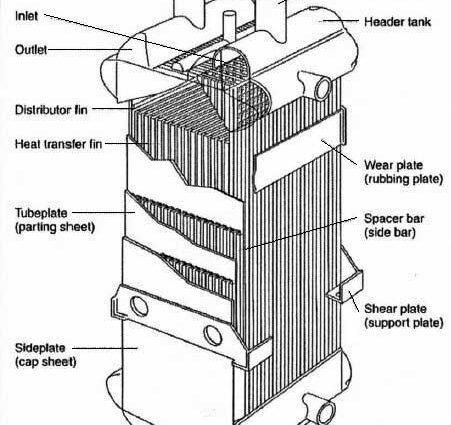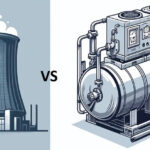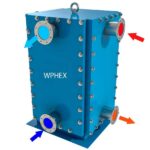Plate fin heat exchangers are a critical component in various industrial processes, offering efficient heat transfer capabilities in compact designs. This article explores the broad spectrum of their applications, recent technological advancements, and delves into the thermal design methodology with a step-by-step approach, emphasizing the equations used. Additionally, we will optimize this article for the keyword “plate fin heat exchangers” to ensure its relevance in the field.
Introduction
Heat exchangers play a pivotal role in countless industries, from HVAC systems to aerospace and petrochemical plants. Among the diverse types of heat exchangers available, plate fin heat exchangers stand out for their versatility, compactness, and efficiency. In this article, we will examine the widespread applications of plate fin heat exchangers, discuss the latest advances in the field, and explore the critical aspects of their thermal design methodology.
Applications of Plate Fin Heat Exchangers
Aerospace Industry
The aerospace industry relies heavily on plate fin heat exchangers due to their ability to provide efficient heat transfer in compact spaces. These heat exchangers are commonly used in aircraft engines to cool various components, including fuel, hydraulic fluids, and even the engine itself. The lightweight and high-performance characteristics of plate fin heat exchangers make them indispensable in aerospace applications, where every pound saved can translate into improved fuel efficiency and overall performance.
Petrochemical Industry
In the petrochemical industry, plate fin heat exchangers find extensive use in processes like natural gas liquefaction, where the need for cryogenic cooling is paramount. These heat exchangers effectively handle the extreme temperature differentials required for liquefying natural gas, making them essential components of the liquefaction process.
HVAC Systems
For heating, ventilation, and air conditioning (HVAC) systems, plate fin heat exchangers are employed to transfer heat between air streams. In these applications, they ensure efficient heating or cooling of indoor spaces. The compact design of plate fin heat exchangers allows for their integration into ductwork, making them ideal for residential and commercial HVAC systems.
Electronics Cooling
As electronic devices become more powerful and compact, managing heat dissipation becomes increasingly challenging. Plate fin heat exchangers have found their way into electronic cooling solutions, where they help dissipate the heat generated by electronic components, preventing overheating and ensuring optimal performance and reliability.
Automotive Applications
In the automotive industry, plate fin heat exchangers are used in engine and transmission oil coolers, intercoolers for turbocharged engines, and radiators for efficient engine cooling. Their lightweight construction and high heat transfer efficiency make them valuable components in modern vehicles, contributing to improved fuel economy and engine performance.
Renewable Energy Systems
Renewable energy systems, such as solar and geothermal, often rely on plate fin heat exchangers to transfer heat efficiently. For example, in solar thermal power plants, these heat exchangers help capture and transfer heat from concentrated solar collectors to generate steam, driving turbines and producing electricity.
Latest Advances in Plate Fin Heat Exchanger Technology
Enhanced Fin Geometries
One of the recent advancements in plate fin heat exchanger technology involves the development of enhanced fin geometries. Researchers have been experimenting with various fin shapes, including wavy and serrated fins, to increase heat transfer rates. These innovative designs create turbulence in the airflow, improving heat exchange efficiency.
Microchannel Plate Fin Heat Exchangers
Microchannel plate fin heat exchangers represent a breakthrough in compact heat exchanger technology. They feature extremely small flow channels and fins, enhancing heat transfer while minimizing size and weight. These microchannel heat exchangers have applications in electronics cooling, automotive air conditioning, and even high-performance computing.
Computational Fluid Dynamics (CFD) Simulations
Advances in computational fluid dynamics (CFD) software have revolutionized the design and optimization of plate fin heat exchangers. Engineers can now simulate and analyse the fluid flow and heat transfer within these heat exchangers with unprecedented accuracy. This enables the development of highly efficient designs and the optimization of existing systems.
Material Innovations
In recent years, material innovations have expanded the capabilities of plate fin heat exchangers. The use of advanced materials, such as graphene-enhanced composites, has improved thermal conductivity and durability, opening up new possibilities for high-performance heat exchangers in demanding environments.
Thermal Design Methodology for Plate Fin Heat Exchangers
Thermal design is a critical aspect of plate fin heat exchanger development. Achieving the desired performance and efficiency necessitates a systematic approach. Here, we’ll outline some equations for thermal design of plate fin heat exchangers, with an emphasis on the equations used.
Define the Heat Exchanger’s Requirements
Before diving into the design process, it’s essential to establish the specific requirements of the heat exchanger. This includes determining the desired heat transfer rate, inlet and outlet temperatures, and the properties of the fluids involved.
Overall Heat Transfer Coefficient (U)
The overall heat transfer coefficient (U) is a crucial parameter in heat exchanger design. It represents the efficiency of the heat transfer process. The equation below is a basic representation to calculate U.
\[\frac{1}{U}=\frac{1}{h1\cdot A}+\frac{t_f}{k_f}+\frac{1}{h2\cdot A}\]
Where:
- U = Overall heat transfer coefficient
- h1 = Convective heat transfer coefficient on the hot side
- A = Heat transfer area
- tf = Fin thickness
- kf = Thermal conductivity of the fin material
- h2 = Convective heat transfer coefficient on the cold side
Required Heat Transfer Area (A)
The required heat transfer area can be calculated using the following equation:
\[Q\ =\ U\ \cdot\ A\ \cdot\ ΔT_{LM}\]
- Q = Heat transfer rate
- U = Overall heat transfer coefficient
- A = Heat transfer area
- ΔTlm = Logarithmic mean temperature difference
Logarithmic Mean Temperature Difference (ΔTlm)
The logarithmic mean temperature difference is a critical factor in heat exchanger design. It is calculated as follows:
\[ΔT_{LM}\ =\frac{ΔT_1\ -\ ΔT_2}{\ln\left(\frac{ΔT_1}{ΔT_2}\right)}\]
Where:
- ΔT1 = Temperature difference between hot fluid inlet and cold fluid outlet
- ΔT2 = Temperature difference between hot fluid outlet and cold fluid inlet
Select Fin Geometries and Materials
The choice of fin geometry and material significantly impacts heat exchanger performance. Engineers must consider factors such as fin spacing, fin thickness, and material conductivity to optimize heat transfer.
Determine Fluid-Side Heat Transfer Coefficients
Accurate values for the convective heat transfer coefficients (h1 and h2) are crucial for thermal design. These coefficients depend on the flow rates, fluid properties, and geometry of the heat exchanger. Empirical correlations or CFD simulations can be used to estimate these coefficients.
Step 7: Iterate and Optimize
The thermal design process often requires iteration to achieve the desired performance. Engineers may need to adjust fin geometries, materials, or flow rates to meet the specified requirements.
Conclusion
Plate fin heat exchangers are indispensable in various industries, offering efficient heat transfer in compact designs. Their applications range from aerospace and petrochemicals to HVAC systems and renewable energy. Recent advancements in fin geometries, microchannel technology, CFD simulations, and materials have further enhanced their performance and versatility.
In thermal design, a systematic approach that includes defining requirements, calculating the overall heat transfer coefficient, determining heat transfer area, and optimizing fin geometries and materials is essential. Plate fin heat exchangers continue to play a crucial role in meeting the ever-evolving demands of modern industries, making them a subject of ongoing research and innovation in the field of heat transfer and thermal engineering.
Other articles of interest












